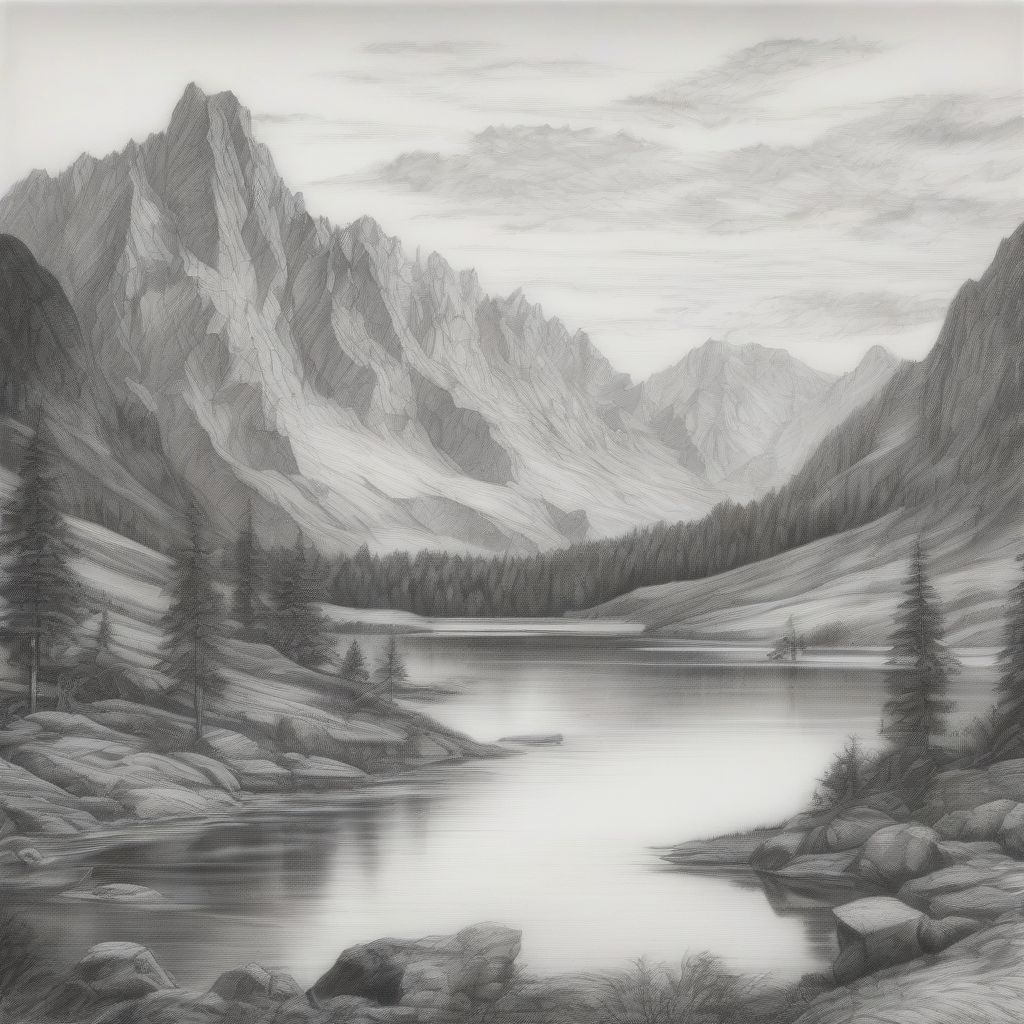Have you ever gazed upon a breathtaking landscape and felt an irresistible urge to capture its beauty? Maybe you’ve even grabbed a pencil and paper, only to feel daunted by the task of translating that three-dimensional wonder onto a flat surface. Don’t worry, you’re not alone! Drawing landscapes is a journey that artists of all levels embark on, and the key is discovering the medium that speaks to your artistic soul.
Choosing Your Artistic Weapons: Exploring Different Mediums
The beauty of landscape drawing lies in its versatility. From the rough texture of charcoal to the vibrant hues of watercolor, each medium offers a unique way to portray the world around us. Let’s delve into some popular choices:
1. Pencil: The Trusty Companion
 Pencil Landscape Drawing
Pencil Landscape Drawing
The humble pencil is often the starting point for any aspiring artist. Its forgiving nature allows for easy corrections and subtle gradations, making it perfect for beginners. Experiment with different pencil grades (from hard H pencils for light sketching to soft B pencils for rich darks) to create depth and contrast in your landscapes.
2. Charcoal: Embracing the Bold and Dramatic
For those who gravitate towards dramatic contrasts and expressive lines, charcoal is a powerful ally. Its ability to create deep blacks and a wide range of tonal values makes it ideal for capturing the rugged beauty of mountains or the dramatic play of light and shadow.
3. Watercolor: A Symphony of Colors
Watercolor’s ethereal quality lends itself beautifully to capturing the transparency of skies, the fluidity of water, and the vibrant hues of nature. This medium is all about embracing the unexpected – letting colors blend and bleed into each other to create stunning washes and subtle transitions.
4. Acrylics: Versatility at Your Fingertips
Acrylic paints are known for their versatility. They can be used thinly for watercolor-like effects or thickly for impasto techniques, adding texture and dimension to your landscapes. Acrylics dry quickly, making them a great option for artists who prefer to work in layers and build up their compositions gradually.
5. Pastels: Softness and Vibrancy Combined
Pastels offer a unique blend of drawing and painting. Their soft texture allows for easy blending and layering, creating luminous effects and vibrant landscapes. From soft, dreamy landscapes to bold, impressionistic pieces, pastels offer a wide range of artistic possibilities.
Essential Techniques for Capturing Nature’s Essence
No matter which medium you choose, there are some fundamental techniques that will elevate your landscape drawings:
1. Observation is Key: Before you put pencil to paper, take the time to truly observe your subject. Notice the shapes, colors, light, and shadow that define the landscape.
2. Perspective: Creating Depth and Dimension: Understanding perspective is crucial for creating realistic landscapes. Use vanishing points to guide the eye and create a sense of depth on your two-dimensional surface.
3. Composition: Guiding the Viewer’s Eye: A well-composed landscape draws the viewer’s eye through the scene. Use elements like leading lines, rule of thirds, and focal points to create a visually appealing composition.
4. Values: The Language of Light and Shadow: Values refer to the lightness or darkness of a color. Mastering values is essential for creating form and depth in your landscapes. Practice shading techniques to create realistic shadows and highlights.
5. Color Theory: Harmonizing Your Palette: Understanding color relationships will enhance the visual impact of your landscapes. Experiment with different color schemes, such as complementary colors or analogous colors, to create harmony and evoke specific moods.
Resources for Your Artistic Journey:
Books:
- “Drawing Scenery: Landscapes and Seascapes” by Claudia Nice
- “Landscape Painting: Essential Concepts and Techniques for Plein Air and Studio Practice” by Mitchell Albala
Online Tutorials:
- Skillshare: Offers a variety of landscape drawing and painting classes for all levels.
- Proko: Provides free anatomy and figure drawing lessons that can be applied to landscape drawing.
Conclusion
Drawing landscapes using different mediums is a rewarding journey of exploration and self-expression. Don’t be afraid to experiment, make mistakes, and discover your unique artistic voice. Remember, the most important tool you have is your own creativity. So grab your chosen medium, step into the great outdoors, and let nature inspire your next masterpiece!
Now, it’s your turn! What medium are you most excited to try for your next landscape drawing? Share your thoughts and experiences in the comments below!
[amazon bestseller=”drawing landscapes”]
